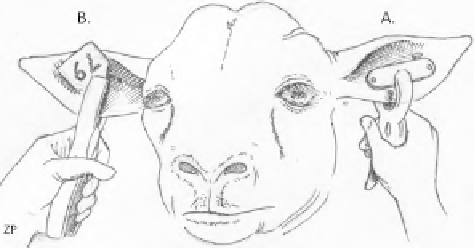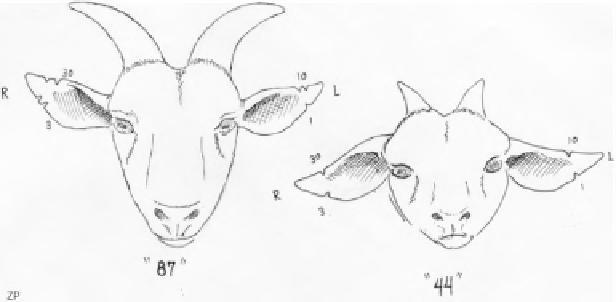Agriculture Reference
In-Depth Information
tattoo pliers, proper digits (alphabets or numbers), and
tattoo ink or paste. Tattooing involves making needlelike
projections in the goat's skin. It is usually done on the
inner aspect of the ear between the ribs of the cartilage in
an area free of hair. The ear is cleaned with gauze or a
towel to remove dirt and wax. Tattoo ink or paste is ini-
tially applied on the area to be tattooed. The goat is ade-
quately restrained, and the tattooing pliers is placed
between the ribs of the cartilage and fi rmly squeezed
(Figure 12.5A). Tattoo ink or paste should be reapplied on
the area where the needlelike projections of the digits are
present on the skin. The tattooing pliers should be placed
in a bucket with disinfectant between treating animals to
prevent any spread of diseases or infection between
animals. The tattooing pliers and digits are thoroughly
cleaned after use each day (Dawson, 2007a; Dawson,
2007b ).
M
ICROCHIPS
AND
R
UMEN
B
OLUSES
This is accomplished by insertion of a microchip in the
base of the ear, or a rumen microchip is placed in the
rumen capable of sending radio frequency waves. A
scanner is needed to identify these animals. Usually these
animals will have a microchip or a rumen chip, along with
an ear tag on the animal, to ensure the integrity of the
microchip identifi cation (Dawson, 2007a ; Dawson, 2007b ).
Nonpermanent Identifi cations
E
AR
T
AGS
Ear tags are an easy way to identify goats in the herd.
Unlike tattoos, they can be read without actually restrain-
ing the goat. Unfortunately, unlike the tattoo and ear notch,
they can break or rip out of the goat's ear. There are two
kinds of ear tags—plastic and metal. To attach either of
E
AR
N
OTCHING
Ear notching has been commonly practiced in identifying
Angora goats. Some of the meat goat associations have
adapted them, with some modifi cations. This system has
the advantage of being visible from a distance, allowing
producers to identify animals without restraining the goats.
A pair of ear-notching pliers is used to put V-shaped
notches on the edges of the ear, and a hole-punch is used
to punch holes in the middle of the ear if necessary. It is
critical that the ear-notching pliers is disinfected between
animals. Generally, the notches on the top of the left ear
are 10, on the bottom edge are 1, on the tip of the ear are
100, and 1,000 a hole at the center of the ear (Figure 12.6).
On the right ear, top of the ear are 30, bottom edge are 3,
on the tip of ear are 300, and 3,000 a hole at the center
(Dawson, 2007a ; Dawson, 2007b ).
Figure 12.5
A: Tattoo pliers is placed between
the ribs of the cartilage and fi rmly squeezed.
B: Ear tags applied with pliers and applied
between the ribs of the cartilage. Drawn by Zeke
Proctor.
Figure 12.6
Right ear edges 3 and
10. Left ear edges 1 and 10.
Redrawn by Zeke Proctor from the
Meat Goat Handbook. Edited by
T.A. Gipson, R.C. Merkel, K.
Williams, and T. Sahlu.









